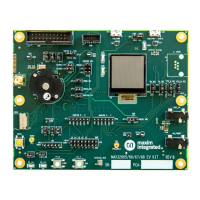MAX32665-MAX32668 User Guide
Maxim Integrated Page 395 of 457
After the 4-bit processing stage is complete, the return value loaded into OWM_DATA.tx_rx consists of 8 bits. The low
nibble (bits 0 through 3) contains the four discrepancy flags: one for each ID bit processed. If the discrepancy bit is set to 1,
it means that either two slaves with differing ID bits in that position both responded (the 2 bits read were both zero), or
that no slaves responded (the 2 bits read were both 1). If the discrepancy bit is set to 0, then the 2 bits read were
complementary (either 0, 1 or 1, 0) meaning that there was no bus conflict.
In this way, at each step in the Search ROM command, the master either follows the ID of the responding slaves or
deselects some of the slaves on the bus in case of a conflict. By the time the end of the 64-bit ROM ID is reached (the
sixteenth 4-bit group processing step), the combination of all bits from the high nibbles of the received data are equal to
the ROM ID of one of the slaves remaining on the bus. Subsequent passes through the Search ROM algorithm are used to
determine additional slave ROM ID values until all slaves are identified. Refer to the Book of iButton Standards for a
detailed explanation of the search function and possible variants of the search algorithm applicable to specific
circumstances.
20.3.7 Resume Communication Command
If more than one 1-Wire slave device is on the bus, then the master must specify which one it wishes to communicate with
each time a new 1-Wire command (starting with a reset pulse) begins. Using the commands discussed previously, this
would normally involve sending the Match ROM command each time, which means the master must explicitly specify the
full 64-bit ROM ID of the part it communicates with for each command.
The Resume Communication command provides a shortcut for this process by allowing the master to repeatedly select the
same device for multiple commands without having to transmit the full ROM ID each time.
When the OWM selects a single device (using the Match ROM or Search ROM commands), an internal flag called the RC (for
Resume Communication) flag is set in the slave device. (Only one device on the bus has this flag set at any one time; the
Skip ROM command selects multiple devices, but the RC flag is not set by the Skip ROM command.)
When the master resets the 1-Wire bus, the RC flag remains set. At this point, it is possible for the master to send the
Resume Communication command. This command does not have a ROM ID attached to it, but the device that has the RC
flag set responds to this command by going to the active state while all other devices deactivate and drop off the 1-Wire
bus.
Issuing any other ROM command clears the RC flag on all devices. So, for example, if a Match ROM command is issued for
device A, its RC flag is set. The Resume Communication command can then be used repeatedly to send commands to device
A. If a Match ROM command is then sent with the ROM ID of device B, the RC flag on device A will clear to 0, and the RC flag
on device B is set.

